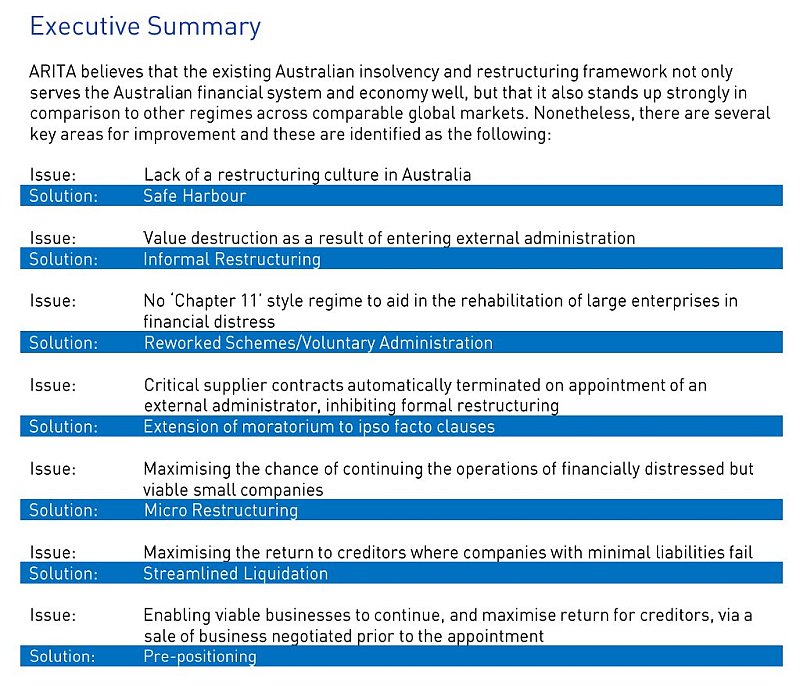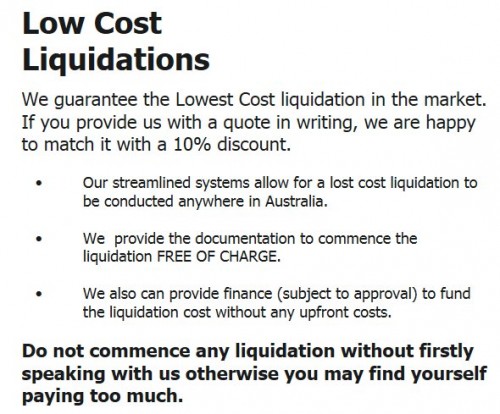On 7 November 2014 an exposure draft of the Insolvency Law Reform Bill 2014 (ILRB 2014) was released by the Australian Treasury for comment.

Summaries:
The Treasury’s summary/promotion of the legislation is as follows:
“The draft Bill comprises a package of proposals to amend and streamline the Bankruptcy Act 1966 and the Corporations Act 2001. The proposed amendments will:
•remove unnecessary costs and increase efficiency in insolvency administrations;
•enhance communication and transparency between stakeholders;
•promote market competition on price and quality;
•boost confidence in the professionalism and competence of insolvency practitioners; and
•remove unnecessary costs from the insolvency industry resulting in around $55.4 million per annum in compliance cost savings.”
The Explanatory Material issued with the Bill opens with this outline:
“The Insolvency Law Reform Bill 2014 (Bill) amends the Corporations Act 2001 (Corporations Act), the Australian Securities and Investments Commission Act 2001 (ASIC Act) and the Bankruptcy Act 1966 (Bankruptcy Act) to create common rules that would:
• remove unnecessary costs and increase efficiency in insolvency administrations;
• align and modernise the registration and disciplinary frameworks that apply to registered liquidators and registered trustees;
• align and modernise a range of specific rules relating to the handling of personal bankruptcies and corporate external administrations;
• enhance communication and transparency between stakeholders;
• promote market competition on price and quality;
• improve the powers available to the corporate regulator to regulate the corporate insolvency market and the ability for both regulators to communicate in relation to insolvency practitioners operating in both the personal and corporate insolvency markets; and
• improve overall confidence in the professionalism and competence of insolvency practitioners.”
Links to government material:
The draft Bill (ILRB 2014) in PDF format
The Explanatory Material in PDF format
The Insolvency Practice Rules – Proposals Paper in PDF format
Coversheet for a submission by post
Previous Bill and background material:
The first version of ILRB 2014 appeared on 19/12/2012 as Insolvency Law Reform Bill 2012, but it never became law. However, the 2012 Explanatory Memorandum and the 2012 Exposure Draft contains valuable background information related to the current Bill. (Sixteen submissions were made for this 2012 consultation.)
Further background information regarding ILRB 2014 is available in the June 2011 Treasury Options Paper titled “A Modernisation and Harmonisation of the Regulatory Framework Applying to Insolvency Practitioners in Australia”. (Thirty three submissions were made for this consultation.)
The 2011 options paper was followed in December 2011 by a Proposals Paper with the same title. (Twenty nine submissions were made for this consultation.)
Submissions regarding ILRB 2014:
Closing date for submissions: Friday, 19 December 2014.
Email submissions are to be done online at:
http://www.treasury.gov.au/ConsultationsandReviews/Consultations/Submission-Form?parent={34029467-07BE-46D9-AA9E-86DAC3715DFF}
Address for written submissions:
Manager
Corporations and Scheme Unit
Financial System and Services Division
The Treasury
Langton Crescent
PARKES ACT 2600
For enquiries call Peter Levy at The Treasury on (02) 6263 3976.
Further posts on this site:
Further posts will be made on this blog site in the coming days with details of some of the proposed changes to corporate insolvency laws.

















